Got questions?
We’ve got answers!
Technical
Phantom Power IEC 61938:2018 standard states that Phantom Power is supplied to be 48V ±4V (44V to 52V) on both pin 2 and pin 3 – referenced to pin 1. We found that some mixing consoles and I/O boxes will provide a slightly lower voltage than 44V. While this is out with the widely used standard, most microphones, DI boxes or any other audio devices that require Phantom Power will still power up and operate just fine.
The former design of the Sound Bullet’s Phantom Power detection was to read Phantom Power and check that its voltage sits within the IEC 61938:2018 voltage standards. However, we decided to implement the capability of detecting voltages between 24V and 44V. When Phantom Power is found to be within that lower voltage range the 48V LEDs on the Sound Bullet will flash slowly, indicating that Phantom is present, however under IEC standards.
When the Phantom Power detected is higher than 52V the 48V LEDs will flash in an alarming way, indicating there is clearly a problem with your Phantom Power supply. Has this ever happened to you? Please let us know on support@sonnect.com
Phantom Power is a voltage of 48V (±4V) which is supplied to both pin 2 and 3 with reference to pin 1 of a console input XLR. So to speak, imagine two 48V batteries with both negative poles connected to the XLR pin 1 and one battery’s positive connected to pin 2 and the other battery’s positive pole connected to pin 3.
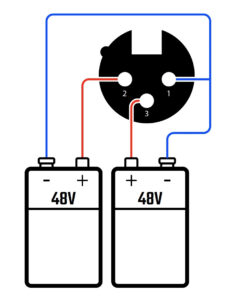
*Phantom Power circuitry is more complex than this but the image should give a good understanding.
Most Phantom Power indicators, for example the LED on a BSS AR-133 DI box will only show you the presence of Phantom Power without indicating whether one of the two legs is broken – in fact, most condenser microphones and DI boxes will still operate even if, say pin 3 of the XLR line is broken.
Being able to individually detect the Phantom Power voltage on pin 2 and pin 3 of the XLR line is very powerful since it can give you an instant diagnosis on the correct functioning of the balanced XLR line which runs all the way from the source on stage to the mixing console.
So for example if the wire soldered to pin 2 of the XLR has come off due to mechanical distress or the wiring is broken somewhere along the cable, the LED relative to pin 2 won’t light up. In 99% of the cases there shouldn’t be any problem with the Phantom Power supply circuitry within the mixing console but the fault will be on the cabling which interconnects your audio device/microphone to the mixing console.*
The Sound Bullet is not designed to test intercom systems. Do you like this functionality? We’d love to hear what you think, drop us an email at hello@sonnect.com
We wanted to ensure the Sound Bullet is a very fast tool to use – without too many buttons to press in order to quickly tackle different testing scenarios.
The headphones output shares the same amplifier as the internal speaker, this allows you to plug your headphones in to listen to an incoming signal without having to press another button – simply plug the headphones in!
The headphones/speaker amplifier is always fed by the 1/4” Jack – this means that if you plug the output of a musical instrument (keyboard, violin, etc) into the Sound Bullet’s 1/4” Jack this will automatically be reproduced by the speaker to check for its presence. This also means that when you route the internal generator to the Jack/Speaker you can instantly monitor whether you are generating pink noise or the 1kHz tone – in case you couldn’t remember if you pressed the signal type button.
Here’s a conceptual diagram to better understand the signal flow:
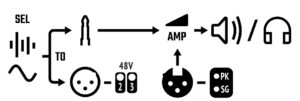
We designed the Sound Bullet to be very practical, hands-on and foolproof. A very handy use of the Sound Bullet is to plug it into the input of a speaker amplifier or of a self-powered speaker to quickly check for its functionality (check this video).
We have done many tests generating pink noise at a variety of output levels. +4 dBu is commonly used to calibrate VU meters, this is very handy, however it is a very hot signal and you wouldn’t want to plug it by mistake into the back of a speaker, because… well you will hear it !! So we decided to go for a more moderate maximum output level … yeah “Sound Bullet” does sound like something that comes out of a gun but we never meant it to be a deafening weapon ;-).
If you were wondering about the other two output levels well, glad you asked! We wanted to make sure the lowest output signal would light up the very lowest LEDs of the input meter of a mixing console*. -40 dBu seemed to light up the lowest input meter LEDs of all major brands of mixing consoles.
-20 dBu just nicely fits in the middle and works as a very usable level when checking the cabling of a self-powered line-array sound system while setting rigging it up in a noisy arena.
*when mixing console is set to default and input gains are set to “minimum”.
The Sound Bullet’s 1/4” Jack simultaneously works as an input as well as an output. This is great but it implies an important compromise, read on…
The impedance of an input should always be higher than the impedance of the output – usually 10 times greater, or more. This is why DI boxes have an impedance of around 1M Ohm while an acoustic guitar has a typical output impedance of 5k to 20k Ohm. Since the 1/4” Jack simultaneously works as input and output, its input/output impedance can only be one and we had to decide which one to pick, that is which function to optimise and which one to compromise.
We thought the function to be performing the best would be when the Jack is used as an output. For example, when you plug the Sound Bullet into a DI box – you’d want to PFL the input channel and observe it’s presence as well as its sonic quality. Whereas when plugging the Sound Bullet into the output of an acoustic guitar or keyboard you’d only want to check its presence as opposed to its quality. Hence we picked a lower impedance of 600 Ohm which works perfect when the Sound Bullet is outputting an unbalanced signal.
When a high-Z instrument output is connected into the Sound Bullet’s 1/4” Jack the impedance system is unmatched meaning the signal you’d hear through the speaker would sound a little quiet and distorted, however you’d still be able to tell that, for example, the signal chain of the pedalboard you’re testing is functional.
If you find this off-putting though, we’ve thrown in a little hack: when you select cable- test mode (press and hold SEL for 2s) the output circuitry is disconnected from the 1/4” Jack, which means its impedance will go a lot higher (3.5K Ohm) this will allow you to get a much better impedance match allowing the signal reproduced by the speaker to be louder and of better quality.
This version of the Sound Bullet doesn’t cable-test the 1/4” Jack. Keep tuned though, we are in plans to develop a version which will have this feature, amongst many others!
Sound Bullet doesn’t generate Phantom Power.
But hey! Do you think it would be useful? We’d love to hear what you think, drop us an email at hello@sonnect.com
The creator and developer of the Sound Bullet, David Scorteccia is based in the UK. The Sound Bullets are manufactured in Perugia – Italy.
Every main part, PCB and chassis is sourced by suppliers within a hundred mile radius from the manufacturing company in Perugia, Italy. The manufacturing company in Italy looks after the assembly, test procedures, fulfilment and invoicing.
The Sound Bullet has an internal speaker which allows you to listen to balanced (XLR) or unbalanced (1/4″ Jack) outputs. The internal gain structure for balanced signals is designed to interact with line-level signals and won’t be sufficient to amplify microphones. Besides, due to the small internal battery, the Sound Bullet isn’t capable to generate 48V Phantom Power.
Charging
Roughly 2 hours. Battery discharge times and lifespan are indications which are always to be estimated since they rely on several variables and factors, including operational temperature, quality of recharge, battery overall-life, etc.
During R&D we carried out several tests where we exposed the Sound Bullet to its maximum current requirements (all LEDs turned on and -10 dBu pink noise sent to the internal speaker at full volume) and in this scenario the battery repeatedly performed for 2 hours and 20 minutes – which is a considerably long time since the Sound Bullet wouldn’t be used for more than, say 20 minutes per test.
Roughly an hour. We have put a lot of thoughts in creating a product which is robust and will last for a very long time in your career. We wanted to make sure the battery lifespan will be as long as possible and one of the main factors that defeats battery-degradation is to allow the battery to not be charged too fast.
When the Sound Bullet is showing “low charge” (LED flashing white 3 times every 6 seconds) you should consider looking for your USB-C cable and find a spare power socket “… where did I put it??”.
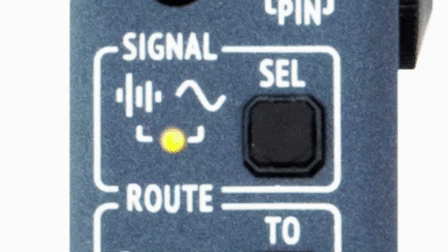
Sound Bullet showing low charge.
When the Sound Bullet’s battery is completely out of charge (device’s functionalities turn off and LED flashes white 6 times every 2 seconds) then it’s time to recharge the Sound Bullet.
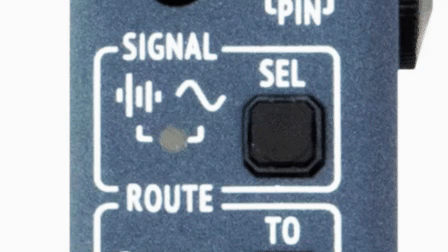
Sound Bullet is completely out of charge.
Simply plug the USB-C charger into the side port and the LED next to it will turn red. When the red LED turns off the battery is fully charged, unplug it and you’re good test some bad-ass lines!
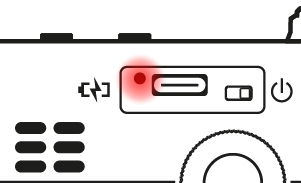
- When the Sound Bullet’s internal battery is at 20% of its capacity the function LED on the top face will flash 3 times every 6 seconds, it’s time to find your charger.
- When the Sound Bullet is completely out of charge the core functions will be switched off and the function LED will flash 6 times every 2 seconds.
Yes.
According to our engineer team (and Ohm’s law!) there is absolutly no problem charging the Sound Bullet with a 5V / 1 ampere or more charger.
Since you use constant voltage (5V) the only factor that determines current draw is the load the Sound Bullet places on the charger.
So the Sound Bullet only draws as much current as it needs and no more.
Discounts and Deductions
Did you know the Sound Bullet is manufactured and fulfilled in Italy? VAT is a tax we have here, consisting of 22% which we add to the value of the goods. This tax can be deducted from your purchase, but you need to be special :). VAT rules apply depending on where you are receiving the goods.
Below are the rules depending on where you are in the world. See which one applies to you:
- European Union:
– If you are VAT registered you will be deducted the VAT amount. When you checkout, please enter your VAT registration number in relevant field.
– If you are not VAT registered then we cannot refund you the VAT amount. Sry..
- Outside of the EU (ie. America, Australia, India):
You are VAT exempt so VAT will be automatically deducted on your purchase. - Italy: The Sound Bullet is manufactured and fulfilled in Italy, if you are a private entity or a company we cannot refund you the VAT amount. In the VAT notes field, please enter your IVA number if you are a business or codice fiscale if you are private entity.
If you are still confused please get in touch with hello@sonnect.com, we don’t bite.
We offer a 5% discount on orders of 5 or more Sound Bullets / SoundWire. Discount will be automatically applied at checkout.
Orders on the website are limited to a maximum of 10 Sound Bullets per order. If you would like to purchase a larger quantity, for your company or for resale, please contact us at sales@sonnect.com
If you have a valid Instrastat VAT number, our website will automatically apply the VAT exemption at checkout.
We use the European VIES server to validate VAT numbers.
If you receive an invalid VAT number warning, please ensure that you have a valid VAT number for intra-Community transactions.
The VIES server may also be temporarily offline for maintenance. It will usually be back up in a short time and you will be able to place an order using your VAT number.
You can check the updated server status for your country at the following link
Payments
If your payment fails, it may be due to insufficient funds, account limitations, or issues with your payment method.
Please follow this steps:
- Check you are using a valid and active payment method.
- Make sure your payment method has sufficient funds or credit.
- If the problem persists, try using a different card or payment option.
Note: Repeated failed transactions can temporarily block your payment method.
If you still encountering error in you payment please contact us
We offer multiple payment options at checkout, including PayPal, Apple Pay, Google Pay, and credit cards.
However, in some cases, such as if you are a public organization, you may need to pay via bank transfer.
Please note that, due to local regulations, we can accept bank transfer payments only in € (EUR).
If you need to pay via wire transfer please contact us
We use an authorize and capture process for all orders. This means your payment is authorized when you place the order, but the actual charge happens only when your order is ready to be shipped.
For standard products, this usually occurs within a few days. For personalised items (for example, products with custom names or prints), the charge may happen a bit later, usually within 7 days, because we need time to prepare your custom product.
If you’ve received the order confirmation email, don’t worry: your order is confirmed, and the payment is securely reserved on your card.
Once your order is shipped, you’ll receive an email with the tracking number and a PDF digital invoice attached. If you have a Sonnect account, you can also find your invoice in your reserved area.
If you haven’t received the email, please contact us with your order number, and we’ll resend the PDF invoice.
Shipping
U.S. Import Duties
Since the trade measures introduced under the Trump administration, products shipped from outside the U.S. may be subject to import duties (tariffs). These are set by U.S. Customs and, unfortunately, are beyond our control.
If your order is shipped to a U.S. address, you’ll need to pay any applicable import duties or taxes when it arrives. The exact amount depends on product type, value, and origin, as determined by U.S. customs regulations.
Please note that our prices do not include these duties. Any extra fees from customs or delivery services are the customer’s responsibility.
By placing your order, you agree to cover any import duties or taxes that may apply.
We ship wordwide using Air Express courier. All deliveries are made by FedEx, DHL or TNT, and are sent using a signed and tracked service.
Available shipping countries are shown at checkout. If your country is not listed, unfortunately we’re unable to ship to that destination.
You can contact one of our nearest local dealers for assistance.
For any further information, please contact us.
We ship from Monday to Friday. Orders received by 11:00 AM (GMT+1) are usually dispatched the same day.
Orders containing customised products (e.g. Sound Bullet + Name Print) are shipped as soon as they are ready, typically within 3 working days from the date of the order.
Express shipping times (once dispatched):
- Europe 1-2 days
- North America 3-4 days
- Rest of the world 4-7 days